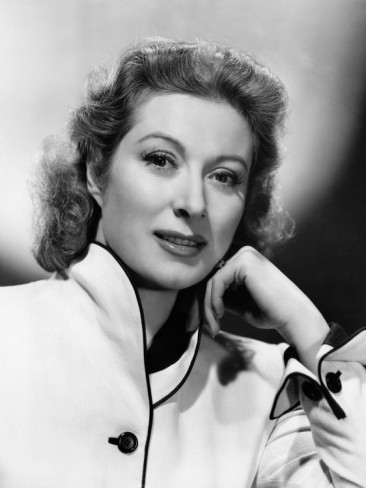Greer Garson (Eileen Evelyn Greer Garson Fogelson)

Greer Garson was born on 29 September 1904 in Manor Park, East Ham, Essex, the only child of Nina (née Nancy Sophia Greer; died 1958) and George Garson (1865–1906), a commercial clerk in a London importing business. Her father was born in London, to Scottish parents, and her mother was from Drumaloor, Casar, County Down, Northern Ireland. The name “Greer” is a contraction of “MacGregor”, another family name. Her maternal grandfather was David Greer, an RIC sergeant in Castlewellan, County Down, Northern Ireland, in the 1880s, who later became a land steward to the Annesley family, wealthy landlords who built the town of Castlewellan. Greer Garson self-identified as Northern Irish. David Greer lived in a large detached house built on the lower part of what was known as Pig Street or known locally as the Back Way near Shilliday’s builder’s yard. The house was called “Claremount” and today the street is named Claremount Avenue. It was often reported that Garson was born in this house. Greer Garson was educated at King’s College London, where she earned degrees in French and 18th-century literature, and at the University of Grenoble in France at a time when few actors had university degrees. She had intended to become a teacher, but instead began working with an advertising agency, and appeared in local theatrical productions. Greer Garson’s early professional appearances were on stage, starting at Birmingham Repertory Theatre in January 1932. She appeared on television during its earliest years (the late 1930s), most notably starring in a 30-minute production of an excerpt of Twelfth Night in May 1937, with Dorothy Black. These live transmissions were part of the BBC’s experimental service from Alexandra Palace, and this is the first known instance of a Shakespeare play performed on television.
Louis B. Mayer discovered Garson while he was in London looking for new talent. Garson was signed to a contract with MGM in late 1937, but did not begin work on her first film, Goodbye, Mr. Chips, until late 1938. She received her first Oscar nomination for the role, but lost to Vivien Leigh for Gone with the Wind. She received critical acclaim the next year for her role as Elizabeth Bennet in the 1940 film, Pride and Prejudice. Garson starred with Joan Crawford in When Ladies Meet in 1941, and that same year became a major box-office star with the sentimental Technicolor drama, Blossoms in the Dust, which brought her the first of five consecutive Best Actress Oscar nominations, tying Bette Davis’ 1938–42 record, which still stands. Garson won the Academy Award for Best Actress in 1942 for her role as a strong British wife and mother in the middle of World War II in Mrs. Miniver. (Guinness Book of World Records credits her with the longest Oscar acceptance speech, at five minutes and 30 seconds, after which the Academy Awards instituted a time limit.) She was also nominated for Madame Curie (1943), Mrs. Parkington (1944), and The Valley of Decision (1945). Greer Garson frequently costarred with Walter Pidgeon, ultimately making eight pictures with him: Blossoms in the Dust (1941), Mrs. Miniver (1942), Madame Curie, Mrs. Parkington, Julia Misbehaves (1948), That Forsyte Woman (1949), The Miniver Story (1950), and Scandal at Scourie (1953).
Greer Garson was partnered with Clark Gable, after his return from war service, in Adventure (1945). The film was advertised with the catch-phrase “Gable’s back and Garson’s got him!” Gable argued for “He put the Arson in Garson”; she countered “She put the Able in Gable!”; thereafter, the safer catchphrase was selected. Garson’s popularity dropped somewhat in the late 1940s, but she remained a prominent film star until the mid-1950s. In 1951, she became a naturalised citizen of the United States. She made only a few films after her MGM contract expired in 1954. In 1958, she received a warm reception on Broadway in Auntie Mame, replacing Rosalind Russell, who had gone to Hollywood to make the film version. In 1960, Garson received her seventh and final Oscar nomination for Sunrise at Campobello, in which she played Eleanor Roosevelt, this time losing to Elizabeth Taylor for BUtterfield 8. Greer was special guest on an episode of the TV series Father Knows Best, playing herself. On 4 October 1956, Garson appeared with Reginald Gardiner as the first two guest stars of the series, in the premiere of NBC’s The Ford Show, Starring Tennessee Ernie Ford. Greer Garson appeared as a mystery guest on What’s My Line on 25 October 1953 and on 6 April 1958 to promote her appearance in Auntie Mame. Garson’s last film, in 1967, was Walt Disney’s The Happiest Millionaire, although she made infrequent television appearances afterwards. In 1968, she narrated the children’s television special The Little Drummer Boy, which continues to be aired on ABC Family. During this time, she also appeared on Laugh-in and the Smothers Brothers Comedy Hour. Greer Garson received an honorary Doctor of Arts degree from Southern Methodist University in Dallas, her late husband’s alma mater, in 1991. In 1993, Queen Elizabeth II recognized Greer Garson’s achievements by investing her as Commander of the Order of the British Empire. In her final years, Garson occupied a penthouse suite at the Presbyterian Hospital in Dallas. She died there from heart failure on 6 April 1996, at the age of 91. She is interred beside her late husband in the Sparkman-Hillcrest Memorial Park Cemetery in Dallas.
Born
- September, 29, 1904
- United Kingdom
- Manor Park, East Ham, Essex, England
Died
- April, 06, 1996
- USA
- Dallas, Texas
Cause of Death
- heart failure
Cemetery
- Sparkman Hillcrest Memorial Park
- Dallas, Texas
- USA



